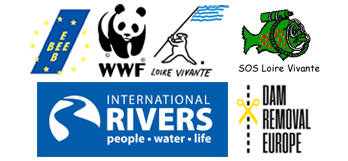Navigation and embankment
Adapte the ships to the river and not the opposit – remove embankments and give more space for the river

CR Roberto Epple ERN

CR Roberto Epple ERN

CR Roberto Epple ERN
Since the successful opposition together with other French ONGs against the construction of a large Rhine-Rhone Canal in the 1990s and afterwards, ERN has not been active in the field of waterway network development.
ERN supports the EU recommendations below.
Europe’s waterways have been used for navigation throughout history, and have been shaped by navigational locks, barrages, groynes, dredged channels and reinforced banks. The WFD recognises these can be functional features, but sets the expectation that unnecessary structures should be removed and that infrastructure should be redesigned wherever possible to improve habitats and fish passage and to restore natural shorelines. Moreover, it sets the expectation that such infrastructure should not lead to further deterioration in the current state of rivers.
RECOMMENDATIONS ON TACKLING NAVIGATION PRESSURE
• Member States should ensure that navigation improvements and waterway maintenance measures are based on transparent assessment of impacts on water status, addressing all quality elements (biological, hydromorphological and physicochemical) and biodiversity. They need to improve methods for assessing potential deterioration due to planned navigation-related (as well as other infrastructure) projects. These should include more targeted methodologies relating specifically to hydromorphological quality elements, when these are not captured in biological quality elements assessment methods. In addition, Member States should develop pre-determined standards for hydromorphological status (high, good, moderate, poor, bad) to improve assessment of risk of new modifications.
• Member States must ensure, and the European Commission should enforce, full compliance with the WFD, as well as the Nature Directives, when new navigation projects and waterway maintenance are developed and implemented.
• Member States should carry out a systematic review of navigational structures to explore required improvements with a view to achieving WFD objectives.
• Member States should ensure that navigation project developers follow, wherever possible, the ‘working with nature’ principle – monitoring, adjusting and learning from the river through a step-by-step approach. They should maintain the natural hydromorphological processes and use engineering interventions only where these prove indispensable and the most sustainable solution. Integrated plans should fully exploit the potential for river restoration and side channel reconnection.
• Due to the multi-disciplinary character of waterways, participatory management is a must: Member States should ensure that all relevant
stakeholders, including environmental organisations, are engaged in the planning process for new navigation projects and maintenance measures to reach commonly accepted solutions.
• Member States should reduce dredging of estuaries to avoid hydromorphological alterations to estuaries, deltas and coasts, and initiate a process of redesigning river ports to reduce their impact on nature.
• Member States should avoid considering river navigation as a means of transport with fixed dimensions throughout the year and instead increase its flexibility by use of modern telemetric means and better logistical connections with other modes of transport.
• Member States and the European Commission should ensure that any existing and future EU transport and navigation policies are compatible with the WFD objectives.
Video
Cliquer ici pour ajouter votre propre texte









 ERN is the official WWF Freshwater Partner in France and cooperates with WWF Switzerland, Austria, Netherlands and others
ERN is the official WWF Freshwater Partner in France and cooperates with WWF Switzerland, Austria, Netherlands and others